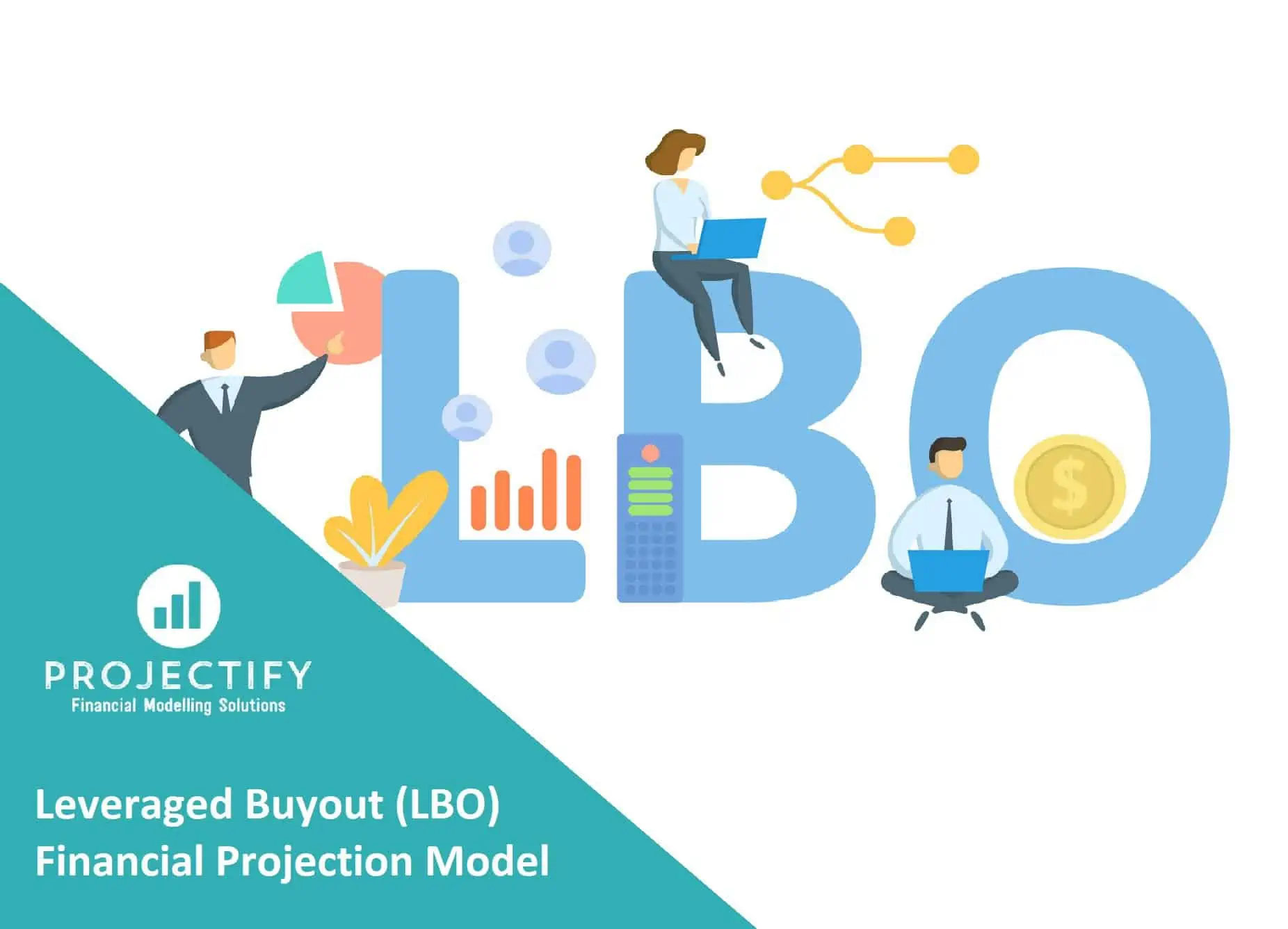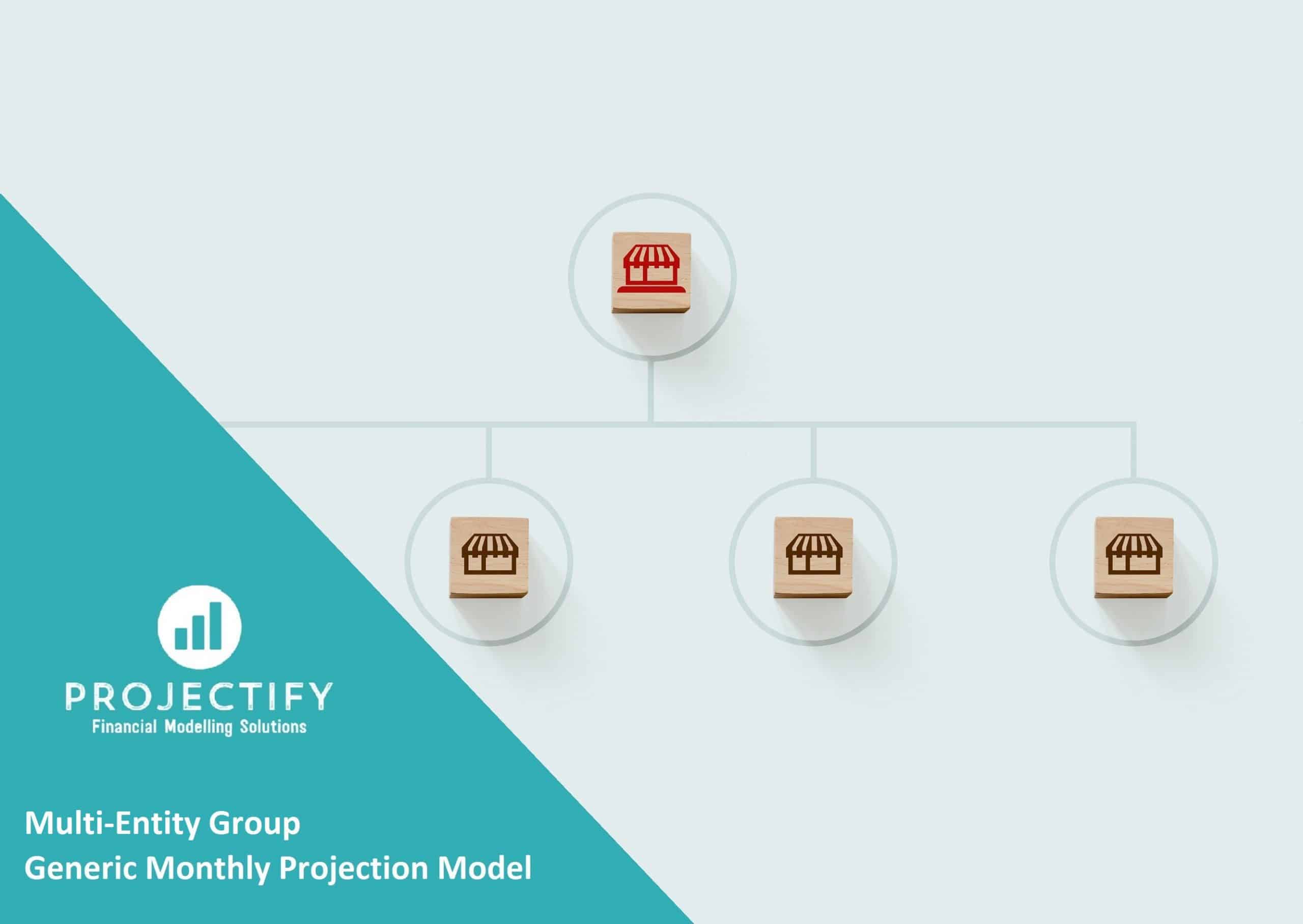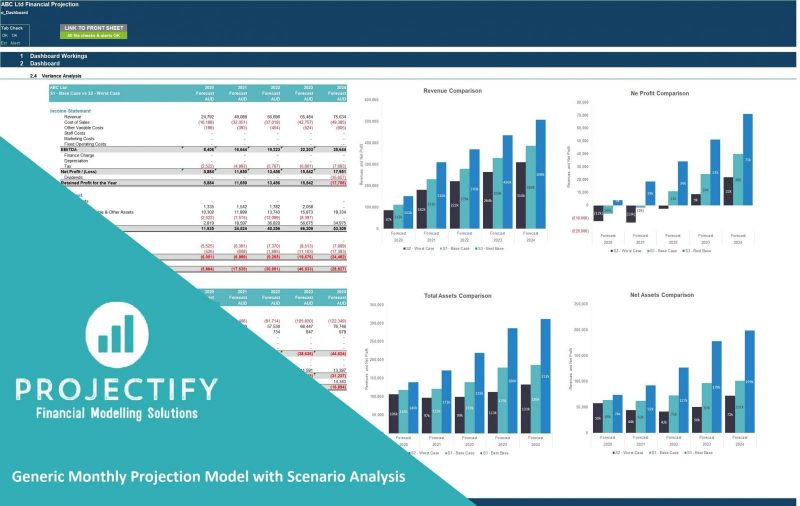Mergers and Acquisition (M&A) Financial Projection Model
User-friendly financial model to project and analyze the financial outcomes and feasibility of an Merger and Acquisition transaction.

PURPOSE OF TOOL
User-friendly financial model to project and analyze the financial outcomes of an M&A transaction. The model enables the user to project the financial performance and position (3-statement financial forecast) over a 5-year period of the stand-alone acquiring business, target business, and merged business with the inclusion of any revenue and cost synergy benefits to the latter. The model also enables the user to qualify the intrinsic value of the stand-alone acquirer, target, and merged business using the discounted cash flow (DCF) approach.
The model compares these outputs in a dashboard to help the user determine the financial feasibility of the M&A transaction including, amongst others:
– Synergy benefits vs consideration
– Revenue, EBITDA, and net profit performance of combined entity vs the sum of stand-alone entities
– Intrinsic enterprise and equity values before and after the transaction
– Gearing, ROE, and margin development pre and post-transaction
– Earnings per share pre and post-transaction
The model includes 3 scenarios for synergy benefits and pro-forma financial statements for the merged business showing goodwill and impact of sources of funds for consideration.
The model follows good practice financial modeling principles and includes instructions, checks, and input validations.
KEY OUTPUTS
The key outputs include:
– Projected full financial statements (Income Statement, Balance Sheet, and Cash flow Statement) across 5 years presented on a yearly basis for the stand-alone acquirer, target, and merged business
– Discounted cash flow valuation using the projected cash flow output for acquirer, target and merged business
– Ratio Analysis based on projected financial statements for an acquirer, target and merged business
– Summarised tables and charts showing:
o Key transaction outputs including, offer/market and intrinsic value per share, total synergy benefits, consideration, and transaction costs
o Charts showing the breakdown of synergy benefits and sources of funds
o Key performance metrics and ratio comparison between acquirer, target and merged entity in table and chart format including revenue growth, EBITDA, net profit, margin, ROE, EPS, and debt to equity ratios)
o Key valuation comparison between acquirer, target and merged entity in table and chart format
KEY INPUTS
Inputs are split into Setup inputs, Acquirer entity inputs, target entity inputs, and merged entity inputs.
Setup Inputs:
– Names of transaction, acquiring entity, and target entity
– Currency;
– Transaction close period;
– Latest share prices and outstanding shares;
– Offer premium and consideration type;
– Transaction costs;
– Naming of synergy scenarios.
Acquiring and Target Entity Projection Inputs:
– Latest P&L and balance sheet actuals;
– Forecast revenue;
– Forecast cost of sales;
– Forecast operating expenses including depreciation;
– Fixed asset additions;
– Borrowing additions/repayments;
– Dividend distributions;
– Tax rate and interest rates;
– Debtor and creditor days;
– Inventory percentage of cost of sales;
– Discount rate and terminal growth rate.
Merged Entity Inputs:
– Synergy benefits (revenue increases, cost reductions) for each scenario
– Tax rate and interest rates;
– Debtor and creditor days;
– Inventory percentage of cost of sales;
– Discount rate and terminal growth rate.
– Borrowing additions/repayments;
– Dividend distributions;
– Pro-forma opening balance sheet adjustments.
MODEL STRUCTURE
The model comprises of 10 tabs split into input (‘i_’), calculation (‘c_’), output (‘o_’) and system tabs. The tabs to be populated by the user are the input tabs which include ‘i_Setup’ for model and transaction general assumptions and ‘i_Acquirer’, ‘i_Target’ and ‘i_Merged’ for specific projection assumptions relating to the stand-alone entity and combined entity. The calculation tabs uses the user-defined inputs to calculate and produce the projection outputs which are presented in the calculation tabs and ‘o_Dashboard’ tab.
System tabs include:
– A ‘Front Sheet’ containing a disclaimer, instructions and contents;
– A checks dashboard containing a summary of checks by tab.
KEY FEATURES
Other key features of this model include the following:
– The model follows good practice financial modelling guidelines and includes instructions, checks and input validations to help ensure input fields are populated accurately;
– The model enables the user to prepare projections for the acquirer, target and merged entity across a 5-year timeline with an additional 3 years of actuals in the case of the acquirer and target stand-alone businesses.
– The model includes the possibility to model synergy benefits across 3 scenarios with a drop-down in the dashboard tab to change scenarios.
– The model is not password protected and can be modified as required following download;
– The model is reviewed using specialized model audit software to help reduce the risk of formula inconsistencies;
– Apart from projecting revenue and costs the model includes the possibility to model receivables and payables, inventory, fixed assets, borrowings, dividends and corporate tax;
– Business names, currency and transaction close date are fully customizable;
– The model included an integrated discounted cash flow valuation for the acquirer, target and merged business using the projected cash flow outputs;
– The model includes a checks dashboard that summarises all the checks included in the various tabs making it easier to identify any errors.
MODIFICATIONS
If you require any be-spoke modifications to the tool, we are more than happy to assist with this. Please send us a message through the Eloquens site or contact us on: [email protected]
ABOUT PROJECTIFY
We are a small team of financial modeling professionals with experience working in big 4 business modeling teams and strong experience supporting businesses with their financial planning and decision support needs. Our aim is to provide robust and easy-to-use models that follow good practice financial modelling guidelines and assist individuals and businesses with key financial planning and analysis processes.
We are keen to make sure our customers are satisfied with the tools / models they purchase and will be more than happy to assist with any questions or support required following or in advance of purchase.
We are also always keen to receive feedback so please do let us know any feedback you have on our models by sending us a message or submitting a review.
Similar Products
Other customers were also interested in...
Leveraged Buyout (LBO) Financial Projection Model
User-friendly financial model to project and analyse the financial outcomes (IRR, projected financia... Read more
Investment Holding Company 3 Statement Financial P...
3 statement 5 or 8 year rolling financial projection Excel model for an investment holding company h... Read more
Private Equity Fund Model (Investor Cashflows)
Private Equity Financial Model to analyze fund cashflows and returns available to Limited Partners (... Read more
Amortization Schedules Template (Loans, Mortgages,...
User friendly template including Amortization Schedules for Loans, Mortgages, Operating and Finance ... Read more
Management Buyout (MBO) Financial Projection Model
User-friendly financial model to project and analyse the financial outcomes of a management buyout (... Read more
Divestiture (Cash Sale) Financial Projection Model
User-friendly financial model to project and analyse the financial outcomes (valuation, projected fi... Read more
Divestiture (Spin Off) Financial Projection Model
User-friendly financial model to project and analyse the financial outcomes (valuation, projected fi... Read more
Multi-Entity Group Generic Monthly 5-Year 3 Statem...
User-friendly 3 statement 5 year rolling financial projection Excel model for a Multi-entity Group (... Read more
Actual vs. Budget Variance Analysis Template
Excel model and dashboard for the preparation of a monthly budget and to track actual performance ag... Read more
Generic 5-Year Monthy Rolling Financial Projection...
PURPOSE OF TOOL Highly versatile and user-friendly Excel model for the preparation of a 5-year rol... Read more
You must log in to submit a review.


















